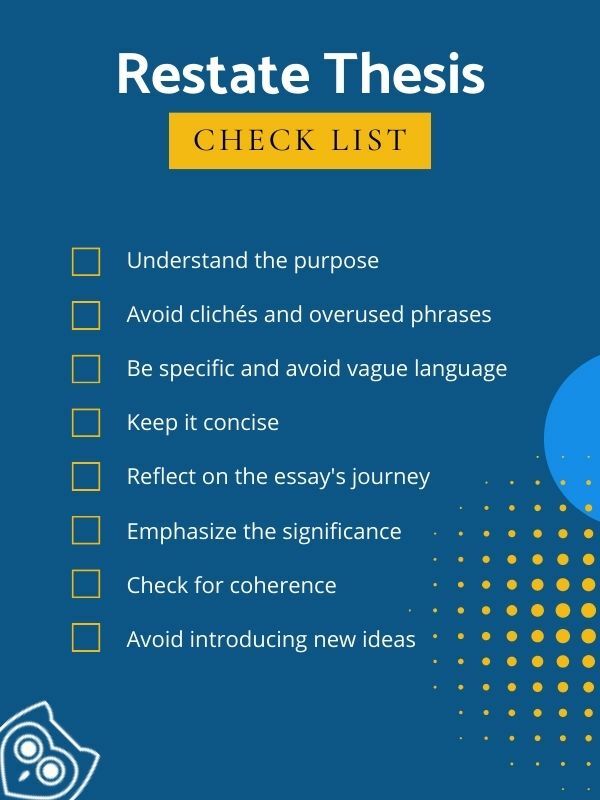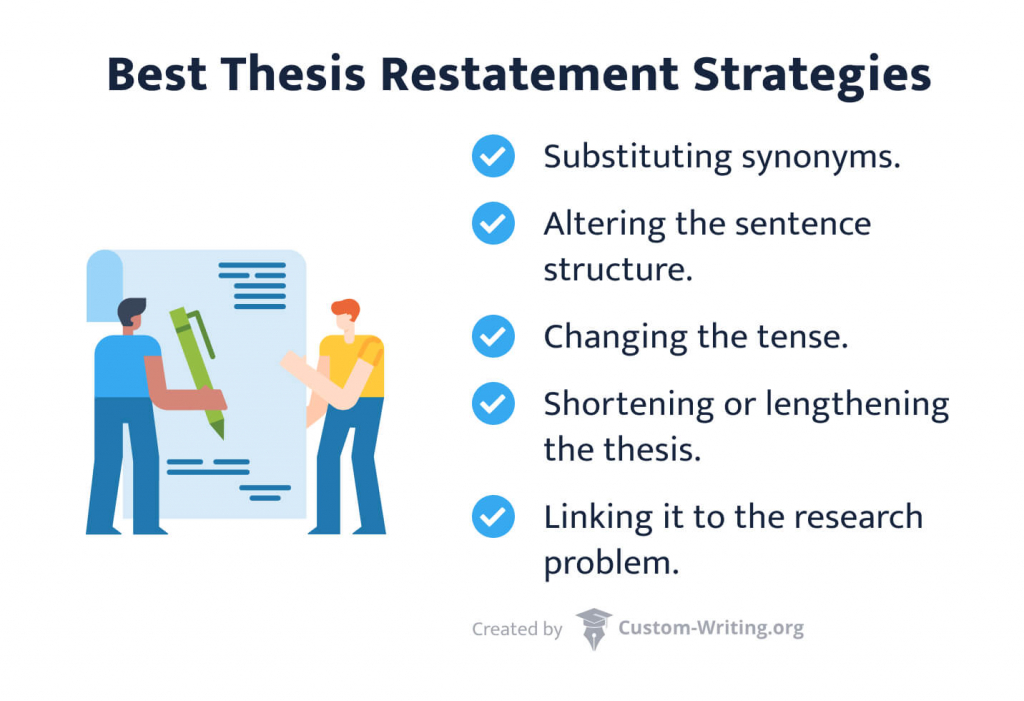

How to Rephrase a Thesis Statement for the Conclusion

A thesis statement is the most critical part of any essay, research paper, term paper, or academic paper.
Most professors, instructors, or teachers will look forward to reading an engaging thesis statement. Another thing they will also focus on is how you restate the thesis in the conclusion of an essay or research paper.
For every thesis in the introduction, there must be a restated thesis statement at the beginning of the conclusion.
If you are not conversant with how to restate a thesis, you came to the right place because we will look at the steps, tips, and strategies to use so that you keep the spirits of your readers high even as they exit reading your piece of written text.
Restating a Thesis
A thesis restatement comes at the beginning of the conclusion paragraph . Note that when restating the thesis, you are simply rewording, restructuring, reorganizing, and representing the original thesis statement in the introduction within your conclusion.
There are many reasons why many professors and guides for writing various types of papers will insist on having a restated thesis as part of the first section of the conclusion paragraph.
Restating the thesis helps the readers to close the loop of reading your text by seeing how you have proven the thesis in your body paragraphs.
It also helps to bring closure to the readers without leaving them in suspense. You are also reintroducing the central argument, enhancing the perceived significance your readers developed as they started reading.
A restated thesis also makes an excellent transition to other parts of the conclusion, such as a call to action, recommendations, or implications.
Steps for Restating a Thesis in a Conclusion
Understanding the thesis restatement process will go a long way in ensuring you achieve the benefits we have discussed above. You want to paraphrase your thesis so that even though they deliver the same message; they have a different organization, structure, and flow, making your writing persuasive and compelling.
1. Read the original thesis statement
After writing your introduction and body paragraphs, it is expected that you will have refined the preliminary thesis statement into a final thesis statement. Now, when you need to restate the thesis, for the purposes of concluding, begin by reading the final thesis statement of your essay or research paper, whatever writing you are undertaking. Reading the original thesis helps you to identify its focus and have a good picture of how to restate it in the conclusion.
2. Decide where you want to place it
Although many people might think that a restated thesis must appear at the beginning of the conclusion, that is not always the case. Therefore, you have to decide where you will place the restatement. At this stage, having an outline of the conclusion paragraph would be ideal, and it will help you figure out where to restate the thesis without making mistakes. All the same, having the restated thesis at the beginning of the introduction saves you time. Writing a conclusion is not cast in stone; you can take whatever approach you like as long as you achieve the intended purpose.
3. Look at the perspective of the original thesis
To restate the thesis better, consider the original thesis's point of view or perspective. You want to maintain the same person you wrote the thesis and the subject, even if it means rewriting the entire thesis.
4. Focus on the main points in the body paragraph
If you feel lost in how to restate the thesis, outline the main points and keywords you presented in the body paragraphs. An excellent way to quickly do this is by reading each topic sentence of the body paragraphs. Remember, your restatement should have the information you have discussed and portray the links you have established in your paper.
5. Express the significance of your argument
You have to justify your paper's central argument to validate the restated thesis. You should let your readers know why they should care about the topic you are writing about. Expand the thesis, so you have the original contribution without altering the intended meaning.
6. Paraphrase the thesis
Having identified everything that sets you up for successful thesis restatement, ensure that you paraphrase the thesis so that you have a restated thesis that meets all the criteria set in the rubric. Let's look at some ways to make the restated thesis stand out.
How to Rephrase or Paraphrase a thesis Effectively
Restating a thesis is about achieving different wording and flow but maintaining the meaning of the original thesis. This can be achieved in many ways. In a nutshell, you can restate the thesis using synonyms, changing the sentence structure and tenses, shortening or lengthening the thesis, and writing the message by linking it to research. Let's have a detailed look at each of these strategies.
Link your thesis to research
If you are writing a research paper or an essay, you must tie the thesis to the research problem stated in your introduction.
Change the Sentence Structure
You can take advantage of the fact that you can play around with the arrangement of words (syntax) as an inspiration to alter your original thesis statement when restarting it. You can restructure the original thesis into smaller or shorter sentences and then combine them again without altering the meaning you presented earlier in the introduction paragraph. You can rearrange the clauses in a sentence but maintain the same meaning.
Shortening or extrapolating the original thesis
A thesis statement is clear and concise. If your initial thesis statement was shorter, consider having a longer restated thesis at the end of your paper. This is always the case with most restatements. It helps spread out the main arguments or points in the body paragraph so that the readers are reminded about what they just read and how your promise in the thesis statement has been achieved. Summarizing the thesis statement when restating it should be done when focusing on the main idea.
Substitute synonyms
To effectively rephrase, paraphrase, or reword a thesis, you can use synonyms of the words used in your original thesis statement. Take advantage of dictionaries and word thesaurus but ensure that you maintain the same meaning without being ambiguous. Thanks to the richness of English in synonyms that mean the same thing, you will not have a lot of challenges restating a thesis using synonyms.
Change the tense
There is power in the way you can use tenses when restating a thesis statement. In most instances, the thesis statement is written in either present or future tense. You can take advantage of this and write a thesis statement in the past tense, emphasizing the main points you discussed in the body paragraphs.
Tips for Thesis Restatement (what works and what doesn't)
We are in the business of writing custom papers for diverse groups of clients, from students to professionals and scholars. Therefore, we keep trying, researching, and reading more about how to perfect the papers we write. Out of the many essays, theses, proposals, research papers, term papers, and dissertations we have written, we can confidently give the tips below as surefire ways to restate the thesis in the conclusion.
- Never apologize when restating a thesis. After all, you have fielded the best proof through evidence and examples supporting your claims in the essay. An apology at this point only weakens your conclusion paragraph, leaving your readers confused even more.
- When writing the thesis statement in the conclusion, acknowledge the counterarguments and counterclaims. Instead of sticking to your main point of view, show maturity by giving credit to either side of an argument.
- Don't use clichés when restating the thesis. It is the same thing as using filler words within your body paragraphs; it dilutes the sweetness of your writing.
- Use conclusion sentence starters to introduce your restatement. You should try as much to avoid the common conclusion starters such as "to sum up, in conclusion, …etc."
- You should reword the original thesis and put it effectively within the beginning of your conclusion, even though you can put it anywhere. It is the easiest approach and makes it easy to locate the restated thesis and allows readers to refocus on the research purpose or purpose of the essay.
- You should be concise while making meaning at the same time.
- You should be objective, focused, and neutral in your stance . Instead of using judgmental language, stay neutral when rewriting the thesis for your introduction.
- You can compile the topic sentences in the body paragraphs and enumerate the central claims when restating the thesis.
- After restating the thesis, you should expound on the significance of your topic . You should logically explain why your readers should care based on the findings. You should call the readers top action and discuss implications and limitations.
- Don't contradict yourself when writing the thesis a second time, as this leaves your readers confused. You should also avoid introducing new information.
- Ensure that your restated thesis has a good choice of words and sound flow and does not counter the meaning of the original thesis . Remember, the thesis and restated thesis are sisters only that have different appearances but stand for the same thing.
- You should view the restated thesis statement as a powerful version of the original thesis that cements your central idea in the readers' minds.
- Avoid using incorrect tenses and modifiers when restating the thesis. When you use the wrong tenses, you confuse the readers, as when you incorrectly modify the subject.
- Be confident as you restate the thesis to have a strong conclusion paragraph.
Examples of Original and Restates Thesis Statements
Below are examples of restating a thesis statement to help you figure out how to do it when writing your conclusion paragraph.
What are the components of a strong thesis?
A strong thesis statement should answer the question of "how?" and "why?" about the topic and should do so with specificity. It takes a stance, justifies discussion, and is specific. Therefore, it should have a specific noun, action verb, and assertive predicate. For instance,
Example: The tax policies (specific noun) of the current administration threaten to reduce (action verb) the tax burden on the middle class by sacrificing education and healthcare programs for anyone ( assertive predicate ). These should also feature when you restate the thesis, even if you rephrase, change the structure or tenses, or shorten the original thesis.
What does rephrasing or restating the thesis statement mean?
It means reading the original thesis and expressing it differently but maintaining the original meaning. The restated thesis is placed in the conclusion paragraph, preferably in the begging immediately after the conclusion starter.
Where does the restated thesis go?
When restating the thesis, placing it at the beginning of your conclusion paragraph immediately after the conclusion paragraph starter helps you to avoid losing your readers. It is the most convenient location, although you can place it anywhere within the conclusion. Placing it at the beginning helps you to have a narrow to the broad conclusion that gives better closure to the readers.
How does one restate the thesis?
To restate the thesis statement, read the original thesis statement, then rephrase it by changing the tenses and structure, using synonyms and different vocabulary, shortening or lengthening it, and paraphrasing it but maintaining the original meaning. Avoid using a thesis generator when restating your thesis because it will not give you the correct feel if you did it alone.

Gradecrest is a professional writing service that provides original model papers. We offer personalized services along with research materials for assistance purposes only. All the materials from our website should be used with proper references. See our Terms of Use Page for proper details.

How to Restate a Thesis: Various Approaches to Restating Your Thesis
Table of contents
- 1 Understanding the Purpose of Restating a Thesis
- 2.1 Paraphrasing.
- 2.2 Summarizing.
- 2.3 Reflecting.
- 2.4 Significance.
- 2.5 Rhetorical Devices.
- 2.6 Emotional Appeal.
- 2.7 Call to Action.
- 2.8 Broader Context.
- 2.9 Engaging Language.
- 2.10 Memorable Statement.
- 3.1 Understand the purpose of restatement
- 3.2 Avoid clichés and overused phrases
- 3.3 Be specific and avoid vague language
- 3.4 Keep it concise
- 3.5 Reflect on the essay’s journey
- 3.6 Emphasize the significance
- 3.7 Check for coherence
- 3.8 Avoid introducing new ideas
A thesis statement guarantees that your essay will be read, and a paraphrased thesis states that the main points of your essay will be remembered. Students have already heard about the importance of formulating a thesis statement to interest the reader in your written work. However, inexperienced authors often forget to restate the thesis.
The purpose of the successful thesis restatement is to reinforce the essay’s main idea. This way, you intensify the original argument and influence the reader’s mind. For your research paper to be convincing, it must be coherent. For this reason, the thesis and the restated thesis should not contradict but complement each other.
In this article, detailed instructions will help you restate your thesis and make your essay memorable. Our experienced specialists are ready to share with you the most working strategies for high-quality rewording of the thesis. Moreover, we want to make it easier for you and have created a checklist of the necessary details to consider to restate your thesis effectively.
Understanding the Purpose of Restating a Thesis
We remind you that the thesis statement is a claim that summarizes the main idea of your essay. It is often used as the first sentence in the introductory paragraph to dedicate the reader to the context of the written work. However, a good thesis statement is not limited to the first paragraph. In academic and persuasive writing, for example, there is a need to restate the original thesis to maintain coherence.
What does restate thesis mean? Let’s start with the fact that a restated thesis is a statement based on the original thesis used in the concluding paragraph or throughout the body paragraphs. Quoting the original thesis statement word by word will not be effective, so you have to analyze the original meaning and reword it. You may use a paraphrasing tool in case you struggle with an issue of how to restate a thesis.
You must be wondering why restating a thesis statement in the conclusion paragraph is so important. It is sometimes difficult for the reader to follow your thought course while reading. Remember when you read a book, then by the last page, you begin to forget about what happened at the beginning. To regularly refresh the reader’s memory of your argument, you need to recall it by restating the original thesis statement in the essay’s conclusion paragraph and body paragraphs.
Thus, the thesis claim should permeate your essay. Each part should contain a reminder of the central idea to reinforce the perceived significance of the thesis word. The restated thesis acts as a link between the main components of your essay. It’s necessary to restate the thesis in conclusion, connect it with topic sentences and provide a logical analysis flow.
Strategies for Restating a Thesis Effectively
Unfortunately, a simple understanding of the importance of restructuring the thesis is insufficient. It is also necessary to understand the primary strategies for good restating. Our PapersOwl experts have prepared a list with good examples for you on how to restate a thesis statement effectively. The most effective strategies are:
Paraphrasing.
Reword your original thesis statement using different words and changing the sentence structure. With this technique, the form changes, but not the main point.
Initial thesis: The desegregation of public schools is considered to be the key purpose of the Civil Rights Movement.
Restatement: The anti-segregation movement in America was aimed at equalizing public schools.
Summarizing.
In this technique, you should analyze and summarize the overall meaning of the original point in the introduction. Thus, the statement will be concise and informative.
Initial thesis: Increased anxiety and stress exposure by the mother during pregnancy can negatively affect the intrauterine development of the child, making his nervous system more vulnerable to stress.
Restatement: A pregnant mother’s stress can make a child more anxious.
Reflecting.
Link your restated thesis to the ideas you uncovered in the body paragraph of the paper.
Initial thesis: The opportunities for women to develop professionally were historically equal to the career prospects of men, or were they?
Restatement of thesis: In the nineteenth century, the inequality in the career opportunities of the two sexes was drastic.
Significance.
Emphasize that the thought you expressed in the original thesis statement is so crucial that it is worth developing in restating the thesis.
Initial thesis: The lack of sex education in schools and families leads to increased unwanted pregnancies among adolescents.
Restatement: Again, 50% of pregnancies among teenagers are unwanted. As a result of the lack of sex education, the total number of teenage pregnancies continues to grow.
Rhetorical Devices.
Use rhetorical techniques in your thesis statement, such as parallelism and repetition, to enhance the persuasiveness of the paper and rephrase the original contribution.
Initial thesis: The film provides a detailed picture for our eyes.
Restatement: The film provides a detailed picture for our eyes, and a book provides an even more detailed image for our mind.
Emotional Appeal.
Use a moving phrase or concept to appeal to the reader’s emotions to enhance interaction. If you don’t know how to apply this technique, try asking for help with college papers , and get expert help.
e.g. How long must pass before people realize that their grandchildren will suffer from the consequences of environmental disasters.
Call to Action.
Formulate your paper’s central argument, and motivate the reader to take action by introducing a thesis restatement in the conclusion.
Example: Do not delay, nature needs your intervention right now, sort garbage responsibly!
Broader Context.
Explain to the reader the background of your thought.
Example: Initial thesis: The world was a millimeter far from a nuclear war.
Restatement: In the 20th century, the development of the nuclear industry reached such a level that the advanced countries were on the verge of starting a nuclear war.
Engaging Language.
Use vocabulary that is close and understandable to the reader.
Example: Lack of sleep is the major reason for heart diseases, so don’t worry, go take a nap!

Memorable Statement.
A powerful version of your original claim has a good potential to be remembered by readers.
Example: Realizing that you owe nothing to anyone is difficult, but only by recognizing this do you begin to live for real.
Checklist to help you ensure an effective restatement of your thesis

Now that you’re familiar with working strategies for paraphrasing a thesis statement, as well as with illustrative examples, it’s time to stock up on all the tips from our experienced writers. We have created a checklist of eight points you need to follow to know how to write a thesis statement for the conclusion section so that most professors truly value your writing.
Understand the purpose of restatement
Understanding the reasons and motivation for your actions gives you the key to rephrase a thesis right. Having realized the primary goal of restating your thesis statement will help you articulate it more clearly. Remember that this writing technique exists to strengthen your arguments and improve their perception by readers. So let’s see how to restate a thesis for your conclusion and write a perfect paper.
Avoid clichés and overused phrases
The reader will not be interested in hackneyed formulations, absolute statements, and overused concepts in your thesis restatement. Our brain always demands novelty, so unique information will attract more attention and arouse interest in your research paper. Try to make your thesis restatement look fresh and intriguing.
Be specific and avoid vague language
Vague concepts, conditional language, overly long sentences, and oversimplification of information will make your thesis statements more boring. Do not think that your reader is a fool. On the contrary, provide him with food for thought. Also, reconsider the sentence structure, for it not to be too weary, use different words to be diverse.
Keep it concise
An excellent conclusion thesis restatement should be concise, giving only the most necessary context to make it easier to understand. You can expand on your idea in more detail in the following main paragraphs. To get a perfect reworded thesis, use the thesis statement generator to make the process easier. Still, to make rephrasing effective, it should be concise, write shorter sentences and use different words.
Reflect on the essay’s journey
Summarize your main ideas. After all, the thesis restatement is precisely the information you want the reader to remember the most. Why don’t you recall once again the main points and central claims of your writing? Use grammar tenses to convey your point. Perhaps your original statement was written in the present or future tense, then use past tense to show you’ve accomplished your ideas. Or, at the beginning of your writing, you used a sentence with a subject. So, restate the thesis in the conclusion with a prepositional phrase instead.
Emphasize the significance
Your opinion and your words must be heard. Emphasize the importance of your ideas with a strong conclusion paragraph thesis restatement. Choose the right strategy for your body paragraphs and paper’s conclusion to sound more convincing. Restate the thesis so that the reader has no doubts regarding the expertise of your writing and the words you say.
Check for coherence
Do not forget about the connection between the thesis sentence in the introduction paragraph and the restatement in the essay conclusion section and the main body. Follow the logic of the presentation of your thoughts when you restate claim. Your paper should not contain contradictory words and statements.
Avoid introducing new ideas
New and creative ideas are good, but they should be pre-planned as part of your paper. An unexpected and unforeseen conclusion that isn’t related to the research problem can confuse the reader at the end of the essay. Stick to your original concepts and the same meaning for the coherence of your writing. Rewrite existing concepts to reinforce your introduction thesis statement.
A thesis statement is an effective technique for attracting the attention of the reader, as well as ensuring his interest. However, using a thesis statement only in the introductory paragraph will not provide you with the desired result. For a more comprehensive result, you will have to rephrase a thesis statement a few more times in the writing process.
No strong conclusion is complete without a good reworded thesis. Remember to connect the rephrasing to the main research question. Use our strategies to write an effective thesis and get a well-deserved assessment from the teacher. Stick to our recommendations to make your paraphrased thesis effective.
Readers also enjoyed

WHY WAIT? PLACE AN ORDER RIGHT NOW!
Just fill out the form, press the button, and have no worries!
We use cookies to give you the best experience possible. By continuing we’ll assume you board with our cookie policy.
How to Restate a Thesis Statement: Examples & Tips
What is the most important part of any essay or research paper? Of course, it’s the thesis statement —a sentence that expresses the paper’s main idea and guides the readers through your arguments.
But where do you place the thesis? You’ve probably answered, “in the introduction.” However, that’s not all of it—you also need to restate the thesis statement in the conclusion. Moreover, it should be paraphrased using a more diverse vocabulary.
If you’re unsure about how to restate a thesis, this article by Custom-Writing.org will be helpful for you. Here, you will find:
- various rephrasing strategies,
- a step-by-step guide,
- the most actionable thesis restatement tips.
- ✍️ Thesis Restatement Definition
- ✅ Step-By-Step Guide
- 💡 Rephrasing Strategies
- 📋 Example Sentences
- 🖼️ How to Reframe
- ✨ Bonus Tips
🔍 References
✍️ what is a restated thesis.
A restated thesis is a reworded and restructured version of the original statement. It is presented in a conclusion or any other part of the essay requiring a recap of the paper’s main idea. It shouldn’t repeat the thesis statement word for word: instead, it’s better to focus on its content.
Why Restating Your Thesis Is Necessary
For a solid, effective academic work, a restated thesis in a conclusion is a must. Here’s why:
- A restated thesis helps reintroduce your central argument, thus enhancing its perceived significance.
- A correctly restated main claim makes the transition to the implications smoother.
- A paraphrased thesis restatement signals the readers about the wrap-up of your paper.
✅ How to Restate a Thesis Step by Step
Now, let’s dwell on the restatement process in more detail. We recommend you follow the steps we described below. It will help you make your paraphrased thesis effective without undermining your persuasive arguments.
💡 How to Rephrase a Thesis: Different Strategies
You can approach the restatement of thesis in several ways. Here are the best strategies that will make your argument effective and easily understood.

How to Restate a Claim by Substituting Synonyms
English is a language rich in synonyms, so you’ll hardly experience any trouble finding suitable substitutes for the words you’ve used in the original thesis. You can also try out an online reword generator or thesis statement maker to get different versions of your central claim.
For instance, imagine that this is your thesis:
People of color have achieved pronounced success in the fight for their civil rights and equality in the USA over the last century,
You may experiment with synonyms as freely as you want. Here are some variants:
- The 20-century civil rights movement gave many rights and freedoms to the minorities in the United States.
- The situation with racial equality improved significantly over the past 100 years, giving racial minorities a strong voice in American society.
Restating Your Thesis by Altering the Sentence Structure
The syntax is also a rich source of inspiration for thesis changes. If the original statement is compound, divide it into several shorter sentences. If you’ve used several simple sentences in the first version, consider combining them into one longer statement.
Here is an example of altering the thesis’ structure without changing the main points:
In the original version, we started by focusing on diabetes. In the reworded thesis, we presented the numbers as the first piece of data. This way, we’re directing the reader’s attention to the gravity of the problem.
How to Restate Your Thesis by Changing the Tense
In most cases, the original thesis statement uses future or present tense. It helps to inform the readers about what they are about to read. For instance, it can start with an introductory phrase:
I will argue that homework should be canceled to give students more free time and ease the burden of high school studies.
In this example, the thesis statement is written in the present tense. It links to the general statistics of time students spend on their homework. You can transform this statement into a past-tense sentence in the conclusion, showing that your argument has been proven.
The presented evidence showed that students benefited from homework cancellation and had more quality time for their hobbies and relaxation.
Restating a Thesis by Shortening or Lengthening It
The length of your thesis statement also matters. You may present it in a shorter way at the beginning of your paper, focusing only on the gist of your research question. Later on, once the arguments are laid out and explained in detail, you can present a more extended version of the initially formulated problem.
In this restates thesis example, we have extended the original idea, explaining what “assigned seating” and “school bullying” mean. This way, the reworded version could embrace the evidence discussed in the argumentative essay’s body.
Restating a Thesis by Linking It to the Research Problem
The strategy we’re about to describe is suitable for use in research paper writing. You will need to tie the thesis statement to the problem you’ve outlined in the introduction, linking it to the issue you’re examining.
For instance, in an essay on child obesity in the USA, you can restate the thesis as follows:
Although preventive healthcare has witnessed much advancement in the past decade, evidence proves that child obesity is still on the rise, with alarming annual increase rates.
📋 How to Restate a Thesis: Example Sentences
Now, let’s examine how to rephrase a sentence in practice. Have a look at these examples:
Example # 1
Here, we expanded the thesis statement by making it longer and adding some details.
Here, we have changed the sentence structure by switching the first and second parts. The first example focuses on the legalization of marijuana, while the second version starts by mentioning the rising rates of teenage weed consumption.
In this example, we’ve changed the thesis statement’s tense from future to past, showing how an intention transformed into a completed task.
🖼️ How to Reframe a Reworded Thesis?
Once you’ve approached the conclusion paragraph of your work, it’s time to think about reframing your main claim. It’s important not to duplicate the introductory thesis because its role in the final section is different. Here are some workable reframing suggestions:
- Reword the original thesis and put it at the beginning of your conclusion. It will bring the focus back to your initial research purpose.
- Enumerate the central claims you’ve focused on. They can be compiled from topic sentences used in the body paragraphs.
- After restating the thesis, you can dwell on the broader significance of the problem you’ve examined. Make a logically related call to action based on the cited evidence. You can also mention your study’s limitations and clarify what additional research is needed.
✨ Bonus Thesis Statement Tips
Now, it’s time to give you a bonus for careful reading: our tried-and-tested tips for good thesis rewriting. Check them out:
As you can see, rephrasing a thesis statement requires effort. Using extensive vocabulary and syntax will help you restructure the content and retain its meaning. And, of course, make sure to follow our tips!
Further reading:
- Best Thesis Statement Examples with Expert Comments
- How to Write a Conclusion for a Research Paper: Examples & Tips
- How to Write a 5-Paragraph Essay: Outline, Examples, & Writing Steps
- What Are the 5 Different Types of Essays? A Complete Guide
- Writing the Conclusion: Indiana University Bloomington
- Writing Introductory and Concluding Paragraphs: University of Minnesota
- How to Restate a Thesis Statement: Classroom: Synonym
- Writing a Paper: Conclusions: Walden University
- Conclusions: Purdue University
- Ending the Essay: Conclusions: Harvard University
- Thesis Statements: University of North Carolina at Chapel Hill
- Share to Facebook
- Share to LinkedIn
- Share to email

If you’re a student, you’ve heard about a formal essay: a factual, research-based paper written in 3rd person. Most students have to produce dozens of them during their educational career. Writing a formal essay is not exactly a piece of cake. But fear not: our custom-writing team is here to...

Rhetorical analysis is never a simple task. This essay type requires you to analyze rhetorical devices in a text and review them from varying perspectives. Such an assignment can be a part of an AP Lang exam or a college home task. Either way, you will need a solid outline...

Narrative essays are unlike anything you wrote throughout your academic career. Instead of writing a formal paper, you need to tell a story. Familiar elements such as evidence and arguments are replaced with exposition and character development. The importance of writing an outline for an essay like this is hard...

Discourse is the way people talk about any specific topic. It’s also the way in which language is used to convey social and historical meanings. Discourse analysis is the process that helps to understand the underlying message of what is being said. Sounds interesting? Keep reading to learn more. This in...

A précis is a brief synopsis of a written piece. It is used to summarize and analyze a text’s main points. If you need to write a précis for a research paper or the AP Lang exam, you’ve come to the right place. In this comprehensive guide by Custom-Writing.org, you’ll...

A synthesis essay requires you to work with multiple sources. You combine the information gathered from them to present a well-rounded argument on a topic. Are you looking for the ultimate guide on synthesis essay writing? You’ve come to the right place! In this guide by our custom writing team,...

Do you know how to make your essay stand out? One of the easiest ways is to start your introduction with a catchy hook. A hook is a phrase or a sentence that helps to grab the reader’s attention. After reading this article by Custom-Writing.org, you will be able to...

A critical analysis essay is an academic paper that requires a thorough examination of theoretical concepts and ideas. It includes a comparison of facts, differentiation between evidence and argument, and identification of biases. Crafting a good paper can be a daunting experience, but it will be much easier if you...

Critical thinking is the process of evaluating and analyzing information. People who use it in everyday life are open to different opinions. They rely on reason and logic when making conclusions about certain issues. A critical thinking essay shows how your thoughts change as you research your topic. This type...

Process analysis is an explanation of how something works or happens. Want to know more? Read the following article prepared by our custom writing specialists and learn about: So, let’s start digging deeper into this topic! ♻️ What Is Process Analysis? A process analysis describes and explains the succession of...

A visual analysis essay is an academic paper type that history and art students often deal with. It consists of a detailed description of an image or object. It can also include an interpretation or an argument that is supported by visual evidence. In this article, our custom writing experts...

Want to know how to write a reflection paper for college or school? To do that, you need to connect your personal experiences with theoretical knowledge. Usually, students are asked to reflect on a documentary, a text, or their experience. Sometimes one needs to write a paper about a lesson...
- How It Works
- PhD thesis writing
- Master thesis writing
- Bachelor thesis writing
- Dissertation writing service
- Dissertation abstract writing
- Thesis proposal writing
- Thesis editing service
- Thesis proofreading service
- Thesis formatting service
- Coursework writing service
- Research paper writing service
- Architecture thesis writing
- Computer science thesis writing
- Engineering thesis writing
- History thesis writing
- MBA thesis writing
- Nursing dissertation writing
- Psychology dissertation writing
- Sociology thesis writing
- Statistics dissertation writing
- Buy dissertation online
- Write my dissertation
- Cheap thesis
- Cheap dissertation
- Custom dissertation
- Dissertation help
- Pay for thesis
- Pay for dissertation
- Senior thesis
- Write my thesis
How to Restate A Thesis: Your Detailed Guide

A thesis acts as your research paper’s main pillar, guiding the readers to the key points on the paper and the direction that you took. A thesis statement comes at the introduction, but you will need to restate it in the conclusion. Notably, a lot of students find this challenging and keep asking, “How do you rephrase a thesis statement?” and “Are you supposed to reword your thesis in the conclusion paragraph?”
To help you restate thesis of your paper appropriately, we have highlighted the key steps that you should follow. Make sure to also check the examples and practice the different ways to restate a thesis until you can hack it like a pro.
What Does Restate Thesis Mean?
Before we can look at the steps involved in restating a thesis, it is important to start by asking the questions, “What does restating means?” and “How long does a thesis restate have to be?”
Restating means that you are highlighting something that you had already brought out, in this case, the “thesis of your paper.” Therefore, you are simply reminding the readers about the points that you were trying to put across in the entire paper, but without sounding repetitive. When it comes to length, there is no specific rule on it, but you should try to make it approximately the same length as the original thesis.
When you restate thesis and conclude the paper well, your work will look complete, professional and earn you a better grade.
Restate Thesis Statement: Decide Where to Position It
In most cases, college students restate the thesis at the start of their conclusion. You might also want to place it on a different section of the conclusion, other than the beginning of the conclusion. When teaching students how to restate a thesis in a conclusion, we recommend them to use the method that will make their work look unique.
For example, instead of restating the thesis as the first sentence, consider starting the conclusion with a rhetoric question followed by your restated thesis statement. Here is an example below. “Will we ever appreciate the importance of saving our rainforests? Rainforests act as the largest carbon sinks on the globe, as well as home to thousands of species, and everyone can play a role in their protection.”
Note that since there is no specific formula on how to restate a thesis statement , it is advisable to start by crafting a draft conclusion and then decide where to position it. Actually, you might consider several positions until you get the perfect spot.
How to Rephrase a Thesis: Make It to have a Deeper Impact
By the time a reader gets to the conclusion of your work, it implies that he/she has already read the entire paper and has a clear idea about your stand on the topic. Therefore, you should take advantage of this and rephrase the thesis statement to deliver a deeper level of emotional effect.
One way of driving this deeper emotional impact is addressing the reader directly, and here is an example. If you were working on a paper with a topic, such as cybersecurity for startups, a good way to start restating the thesis might be:
- “As a startup enterprise owner …”
- “To strengthen your information security as a small business owner …”
Ways to Restate a Thesis: Answer the Question, “So What?”
The stated thesis at the start of your introduction might not provide the answer to the question, “so what?” However, the restated thesis , in your conclusion, should comprehensively answer the question. The answer seeks to inform the reader about the significance of the arguments in the paper to avoid leaving him/her hanging.
For example, if your paper was talking about teenage alcohol and substance abuse, make sure to answer the question “So what?” by showing what it does to teenagers. This can be something such as this; “ Additional awareness of the dangers of substance abuse, such as alcohol, should be emphasized because teenagers are more prone and likely to give in because of peer pressure rather than the implications of substance abuse.”
Avoid Making Apologies when Rewording a Thesis
When working on the conclusion of your paper, it is prudent to be confident that you provided ample proof in the body. Therefore, as you restate the thesis, you should not make apologetic statements because they undermine your argument. Such statements, which you should avoid, include:
“It appears that …. “ “It is possible that …” “It is my opinion that …”
The only time when using such statements when restating your thesis might be okay is when the topic of discussion was simply a possibility.
Restate Thesis Statement by Varying the Tense
When writing an paper, the thesis statement at the introduction might have been done in the future tense, informing the reader what to anticipate in the rest of the paper.
For example, a paper looking at coal production might have a thesis such as this, “ I will examine the effects of using coal in Azerbaijan ….” When restating the thesis, you can change the tense, and put it in the past, so that it looks something like this, “ I evaluated the how harmful the use of coal is to the environment in Azerbaijan …”
Seek Writing Help to Restate Thesis of Your Paper
When you work on any piece of assignment, how you wrap it up, especially in the conclusion, is very important to avoid leaving your reader in suspense. In this post, we have demonstrated how to restate a thesis statement, but you should consider reading a carefully done restate thesis and practice more to hone your skills. However, if you are still finding the task a challenge, even after reading a restate thesis example, consider seeking writing help from an expert.
We have a pool of qualified writers who are ready to help you with your academic assignments, and all you have to do is ask us for help to “restate my thesis.” They know how to start a paper, write the body professionally, and restate the thesis like pros. Furthermore, our services are cheap, and you can count on our writers for quality work and top grades.

Leave a Reply Cancel reply
Your email address will not be published. Required fields are marked *
Comment * Error message
Name * Error message
Email * Error message
Save my name, email, and website in this browser for the next time I comment.
As Putin continues killing civilians, bombing kindergartens, and threatening WWIII, Ukraine fights for the world's peaceful future.
Ukraine Live Updates

IMAGES
VIDEO
COMMENTS
To restate a thesis statement, rephrase your original idea in new words, summarize your argument, and reflect on the overall significance of your essay without repeating your thesis word-for-word.
Here are effective steps on how to create an effective restated thesis statement: Step 1. Review your statement. Begin by revisiting your original phrase from the introduction of your argumentative essay. Ensure you …
In the conclusion, you should restate the thesis and show how it has been developed through the body of the paper. Briefly summarize the key arguments made in the body, showing how each of them contributes to proving …
In our article, we'll guide you through various approaches and techniques to restate your thesis effectively. Unlock the secrets to paraphrasing, highlighting key points, and maintaining a consistent and impactful writing style.
For a solid, effective academic work, a restated thesis in a conclusion is a must. Here’s why: A restated thesis helps reintroduce your central argument, thus enhancing its perceived significance. A correctly restated main …
To help you restate thesis of your paper appropriately, we have highlighted the key steps that you should follow. Make sure to also check the examples and practice the different ways to restate a thesis until you can hack it like a pro.
How to restate a thesis: When concluding your essay or research paper, it’s essential to maintain the original meaning of your argument in the restatement of your thesis …